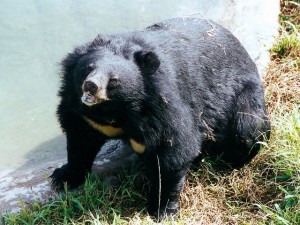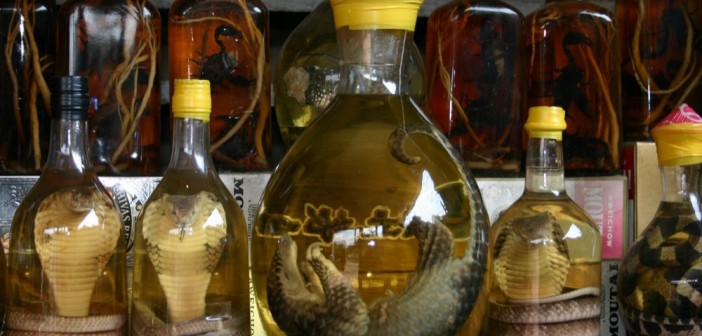(Featured image: pangolin, cobras, and other wild animals for sale in Hanoi, Vietnam. Demand for exotic animal products in China has fueled wildlife trafficking throughout Asia and overseas. Photo credit squishyray, used under CC BY-NC 2.0)
This month, the National People’s Congress is soliciting public comments on four draft laws. One is the revision of the Wildlife Protection Law, which came into effect in 1989. Ironically, the law, supposedly designed to protect wildlife species, has witnessed the enormous rise of a wildlife exploitation industry unlike anything in China’s past.
In 2003, the State Forestry Bureau, the national government agency responsible for enforcing the law, announced glowingly that China had succeeded in domesticating 54 wildlife species as an accomplishment of implementing the law. Indeed, more Asiatic black bears have been farmed in cages for bile extraction since the law’s adoption than before. Thousands more tigers have been raised in cages in northeast and southwest China. Does wildlife farming equal wildlife protection?

Moon bear rescued from bile farm at Animals Asia’s Pan Yu sanctuary (Photo credit: Kim Bartlett – Animal People, Inc.)
The consumption of wildlife has continued unabated. Since most exotic animals are no longer found on the mainland, traders have headed to other regions for their prized supplies. Bear paws are smuggled from Siberia. Pangolins are shipped from Africa, Southeast Asia and South Asia. Freshwater turtles from North America and internationally protected sea turtles from the disputed waters of the South China Sea find their way to restaurants in China. A so-called “tiger trail” connected to the Chinese market threatens the remaining tiger population on the Indian subcontinent.
It is no secret that China is the main destination of global ivory trafficking. Reports over the past two years have also found that Chinese zoos and other institutions have been importing protected species for display and other purposes. Chinese trophy hunters and buyers are eyeing African lions and Canadian polar bears.
Clearly, the law has failed to curb the seemingly insatiable appetite for wildlife species in China and around the world.
Criticism of the toothless legislation has been heard by authorities. In September 2013, the NPC decided to put a revision of the law on the legislative agenda. The draft revision released for public comment is the result of that decision. However, the revision is a far cry from the wishes of wildlife experts, animal conservationists and other parties that have a stake in a new and enforceable law.
The original law is a product of the prevailing mindset at the time that “protection has to serve the objective of economic modernisation”. Thus, wildlife was defined as a “natural resource” to be used for human benefit.
The law promotes a confusing and contradictory set of objectives: protecting wildlife resources, supporting the reasonable use of wildlife, and maintaining an ecological balance. Articles and provisions on measures for regulating wildlife domestication and utilisation dominate. Stipulations against illegal hunting, trapping and trading in protected species are general and toothless. Provisions against cruelty to wild animals, on farms or in other captive institutions, are non-existent.
To Beijing’s Capital Animal Welfare Association, the draft revision remains a “resource utilisation law”. The term “wildlife utilisation” appears eight times in the current law. Yet it appears 24 times in the revision. Similarly, “wildlife domestication and breeding” appears 11 times now; in the draft, it is repeated 25 times.

Fisherman and captive cormorant in Guilin, China. Today, cormorant fishing serves mostly as a tourist attraction rather than a direct source of food (Photo credit: Wolf Clifton – Animal People, Inc.)
The revised law has tried to avoid the term “wildlife resources”. Yet the added text, accounting for a third of the body of the original law, is mostly devoted to provisions on how to legally use wild animals, rather than stipulations for protecting and keeping the species in the wild. The revised law also does not require a national commitment to compensate for the damage caused by protected species.
Admittedly, wildlife use cannot be avoided completely. Yet the association believes wildlife use would have no place if the following eight situations were included: if such use damages the ecological balance; if animals are tortured; when substitutes are available; if it goes against public morality; misleads the public about wildlife; damages the country’s reputation; promotes misguided consumption; and, encourages transnational wildlife crime.
Captive breeding is important only if it is conducted scientifically to stop the downward spiral of the wild population of a target species. China’s massive bear farming, promoted as a conservation project and a public health “wonder”, is wholly a commercial activity. It has made no conservation contributions. Tiger farming was started as a commercial endeavour, though it has been advertised as a conservation project. The remaining few South China tigers are in captivity. There are fewer than 30 Siberian tigers roaming in northeast China.
China has no anti-cruelty legislation. Critics expected the draft revision to contain provisions against cruelty to wildlife, but it is silent on the issue. If this draft revision comes into effect, inhumane farming practices will continue, random violence carried out on zoo animals will go unpunished, and animal performances, photo-ops with tethered animals and live feeding – publicly condemned cruelty to captive wildlife – will go on as usual.
The draft revision has fallen far short of the expectations of the Chinese public for an enforceable and truly “protective” law. The revision efforts are, in the words of one Beijing scholar, “window dressing”. The mindset of “protection cannot be divorced from utilisation for human benefits” seems to have guided the effort. Clearly, the draft revision fails in its response to the party’s ambition of building an “ecologically civilised China”.
China’s reputation as a responsible stakeholder in global wildlife protection efforts calls for Beijing to move beyond the concept of wildlife as a “natural resource” and enact a real “protection law”.
(Originally published January 29th, 2016 on the South China Morning Post)






2 Comments
Another good article on the proposed amendment by Grace Gabriel of IFAW, discussing some of the specific items in the draft and their consequences:
https://www.linkedin.com/pulse/wildlife-law-revision-a-step-backwards-grace-gabriel?trk=pulse_spock-articles